The History of the Titans, Part 2
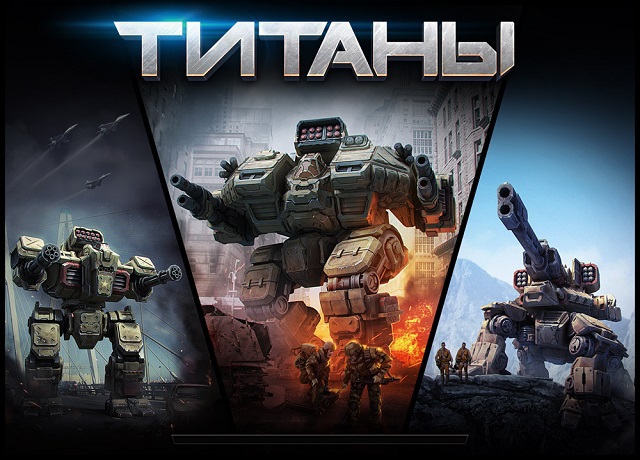
The first part of the history of the Titans ended on the fact that we completed the development of a new social midcore strategy. The game in test mode was launched in Odnoklassniki, and a full launch took place on August 15. Almost a month after the release, we studied statistics, and we can say that the launch was quite successful. Today I suggest you look at the real statistics of the modern social game, and also try to make assumptions about possible changes in the game based on it.
Launch
So, on Friday, August 15, after several weeks of polishing, testing and preparing the infrastructure, the Titans entered the catalog of new applications. Over the first weekend, we got 101,000 units from there (along with virality), and then another 111,000 over the next week. Now the number of daily installations has stabilized at around 10,000. According to representatives of Odnoklassniki, this is a good indicator for playing our genre.
The effect of getting into the catalog of new games on OK
Of course, we wanted to get the most installations from the catalog - we won’t have a second chance on the platform. And how does a new user decide to launch an unknown application? First of all, of course, everyone looks at the title and cover. So we had to choose the optimal picture, which would not be lost among the neighbors and approximately correspond to the real content of the game. Fortunately, on this important issue, we had the opportunity not to rely on intuition, but to conduct a real experiment. Having drawn several dozens of different banner options, we launched them into targeted advertising during a soft lunch. Then, after several iterations, they simply made a cover from a banner that showed the best conversion from impressions to installations.
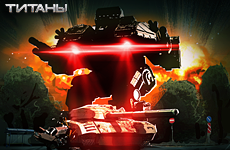
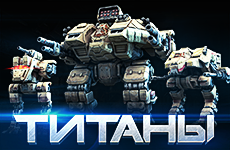
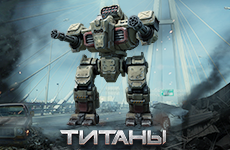
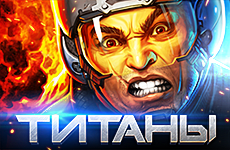
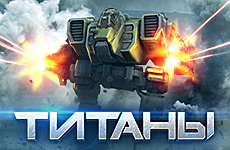
Check your intuition and try to sort these banners by efficiency.
A few words can be said about demography. As you, I think, understood, “Titans” is a game for men. So the key indicators (return and engagement) for them turned out to be predictably higher. Moreover, of all ages, men 27-40 years old showed the greatest activity. Here are the complete demographic statistics for players coming from the directory:
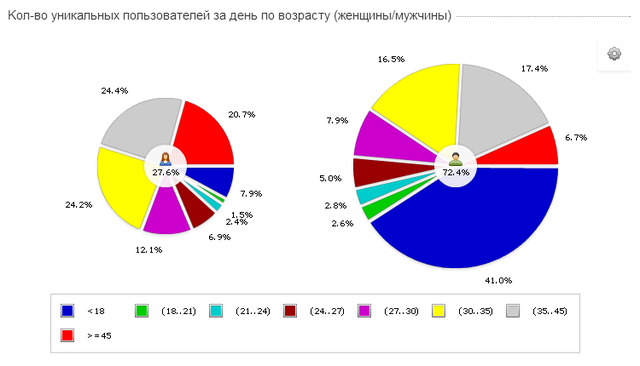
Demographics of new users, Odnoklassniki data
Backend
The sharp jump in 100,000 new installations is always a serious challenge for the infrastructure. To pass it with dignity, you must either have a serious margin in performance on all the main nodes of the system, or immediately make it scalable. In the previous part, I talked about the fact that based on our experience, we decided to go the second way and immediately launch the Titans in the Amazon cloud. But, unfortunately, before the release, we did not have time to fully configure the autoscaling system. Therefore, in order to cope with the sharp peak of the load at startup, we raised our hands in the cloud and connected four EC2 instances to the balancer. As you can see, in the structure of expenses they just occupy the most significant place.
Schedule of daily spending on infrastructure of the Titans, data from the AWS admin panel
On the other hand, the service DynamoDB, in which we store profiles, did an excellent job with a sharp influx of players. Using our script, he easily adapted to the load jump, and now its daily maintenance costs about the same as a regular static server. At the next stage in the development of the system, we want to connect a script to quickly turn on / off EC2 instances, and then, finally, combine them into an automatic load balancing system. After that, we will complete the system of asynchronous statistics recording and, thus, our infrastructure will become fully scalable.
Real statistics
Three weeks have passed since the launch, and you can study the key indicators of the game. To make the picture more complete, we will compare the behavior of users who came from the catalog with those who clicked on our banner during the “soft lunch”. For greater objectivity, I also added to the comparison the real indicators of the game “Knights: Battle of Heroes”. A year and a half ago, knights were successfully launched in Russian networks by our friends - the company "Playkot". We know that now this game is constantly in the Top Grossing of Russian networks and Facebook, so its performance can be used as a benchmark.So, first return in the first month of the game. On the X axis, we have the amount of time that has passed since the user installed the application. The graph shows the average values for the last 30 days:
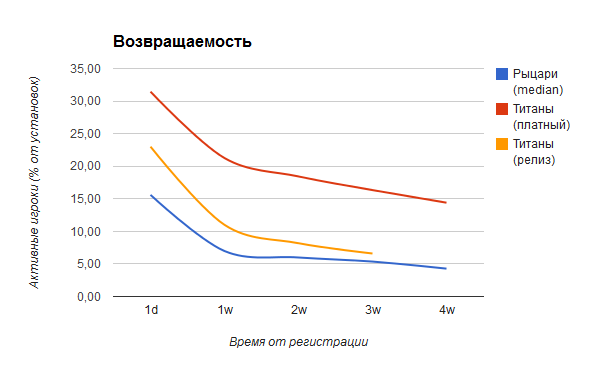
The return
rate fell during the launch, but not critically. It can be seen that the excellent return rates that we observed among interested users (who clicked on the banner) sagged noticeably during the launch, but still turned out to be higher than that of the Knights. Here, statistics confirm the assumption that the game really makes a pretty strong impression on the players.
Now let's arrange a breakdown and look at the "money" charts:
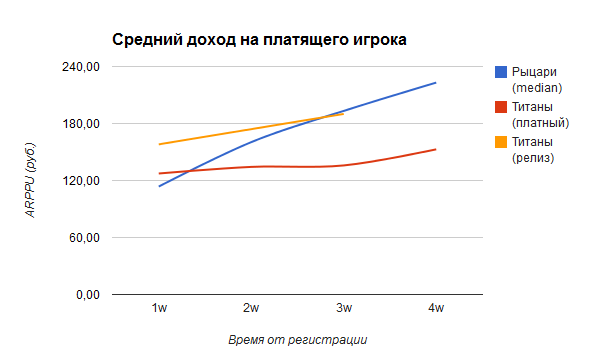
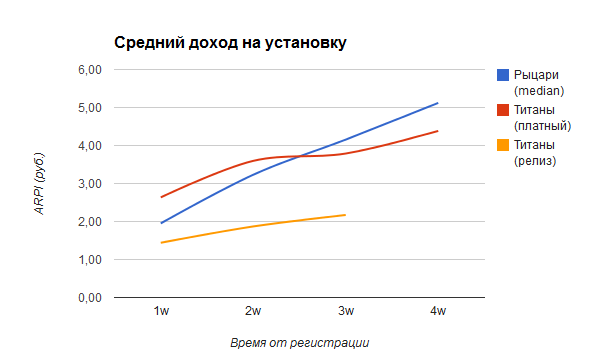
Income for a paying player is good, but it is not growing fast enough
We can say that the income per paying user is not bad in the first week, but over time it is not growing very actively. This indicator, in turn, directly (with the standard for the genre share of paying players at 1-2%) affects the average revenue per installation. It can be assumed that after a week of active play, users stumble upon some kind of barrier in gameplay that interferes with further involvement in the game. And the activity of paying users here can be used as an integral indicator for assessing the objective quality of gameplay. In simple terms, the more interesting the game, the more likely it is that users in it will “vote in rubles.” Despite the possible presence of this barrier, by the end of the first month we are still transferring for 4 rubles for installation, thereby eliminating the average cost of buying advertising. Please note that with a comparable ARPPU (Average Revenue Per Paying User), revenue for one organic installation was significantly lower than for banner. This is primarily due to lower rates of return and conversion in paying.
Debriefing
Now, after we have studied the real statistics, the fun begins. You need to understand what to do next with the game. At first glance, nothing complicated: from the point of view of business, by the end of the first month we need a higher ARPPU. So, you need to increase user engagement in the gameplay after one to two weeks of play. But what exactly needs to be changed for this? Should I make more varied fights? Maybe add more weapons and robots to the game? Refine the mechanism of PVP and matchmaking? Maybe just double the price?The options are incredibly many, each of them can potentially bring us closer to the goal. In conditions of limited resources, it is necessary to somehow prioritize. The changes should be significant enough so that the effect of them can be distinguished in the standard noise for indicators. On the other hand, none of us wants to get into a crazy long-term construction (such as the "global war of clans over the territory") that would paralyze the work of the entire team for many months.
In addition, indicators are a fairly objective thing, but they can be interpreted in completely different ways. Therefore, no matter how seductive the next hypothesis may seem, we must always remember that this is only one of the possible interpretations of real data. Nevertheless, from time to time to listen to intuition is still worth it. Over the years spent in game dev, she repeatedly prompted us the right steps.
In an effort to make the best use of our time, we established the following simple rule: before removing the alleged barrier in gameplay, you must first try to very clearly identify the problem being solved. In addition, the effect of game design changes must be measurable.
Using these principles, we selected the most probable hypotheses, which are yet to be tested in the coming month:
- At some point, the difficulty of advancing the game increases dramatically, thereby reducing the motivation for an active game.
Check: analyze the accumulated statistics, find the moment of decrease in activity. Search for distortions in the balance in this place, correct them. - Players do not see a clearly defined goal for which it would be worth actively pumping out a squad of Battle Robots.
Check: Add to the game a campaign of several dozen missions with increasing complexity. - The game has too little content, there is no sense of perspective and great opportunities.
Check: Add more content to the game (new robots, weapons, shields, armor)
What's next?
Firstly, in August, Julia, a first-class specialist in UI and UX, joined our team. Now, when the passions after the successful launch have weakened a bit, you can spend some time trying to fix the numerous problems of the Titans interface that have accumulated over the development period. We have already managed to replace several windows in the game that caused the most questions. The result made a strong impression on everyone, so we plan to continue to move in this direction, correcting the old jambs and preventing the appearance of new ones in the windows that we have yet to make up: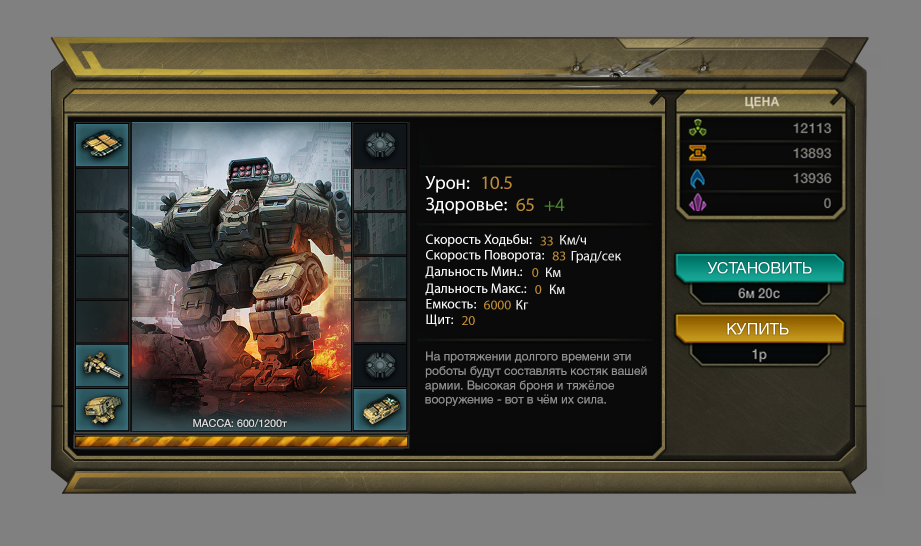
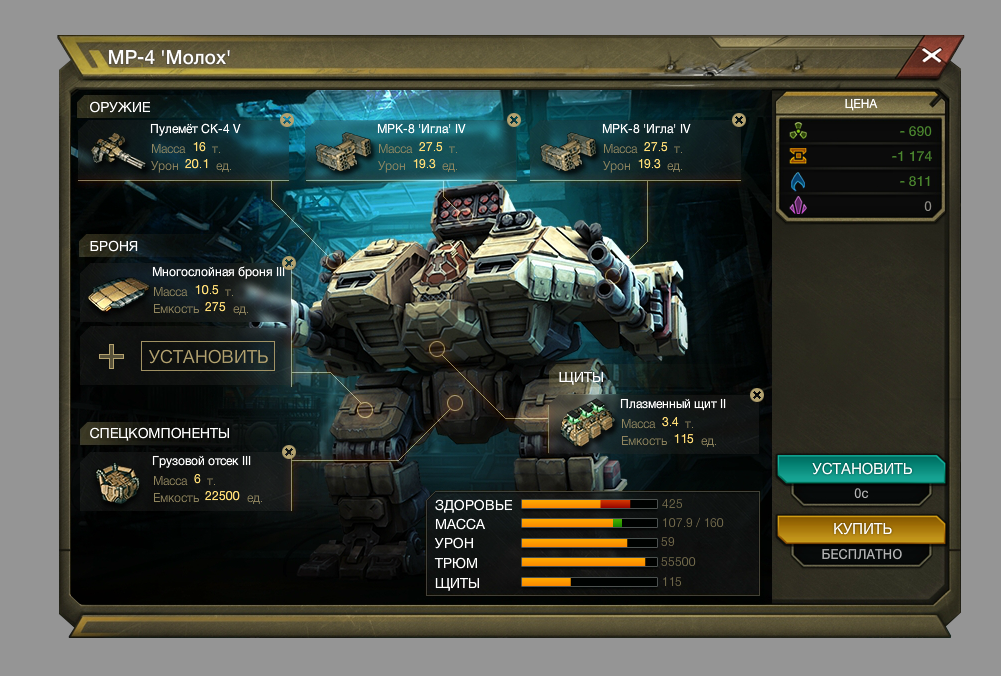
Robot modification window. It was
Secondly, we want to start on Vkontakte in October, together with the start of the season of player activity. In addition, we have already begun to prepare the game for localization, so that by the end of the year we will go to the “soft lunch” on Facebook.
And, of course, we continue to actively seek opportunities for meaningful changes to the game. When the art department has a moment free from creating stunning graphics, they help determine directions, creating illustrations for our concepts of various features. Having such a picture in front of your eyes, it is much easier to imagine a holistic image of how the feature will work and combine the existing elements of the game:
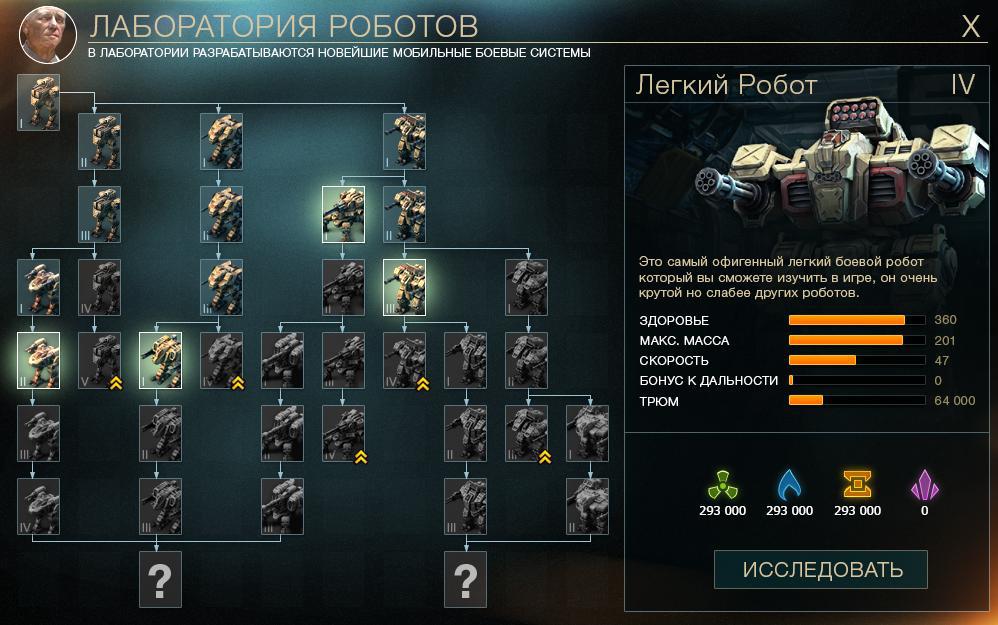
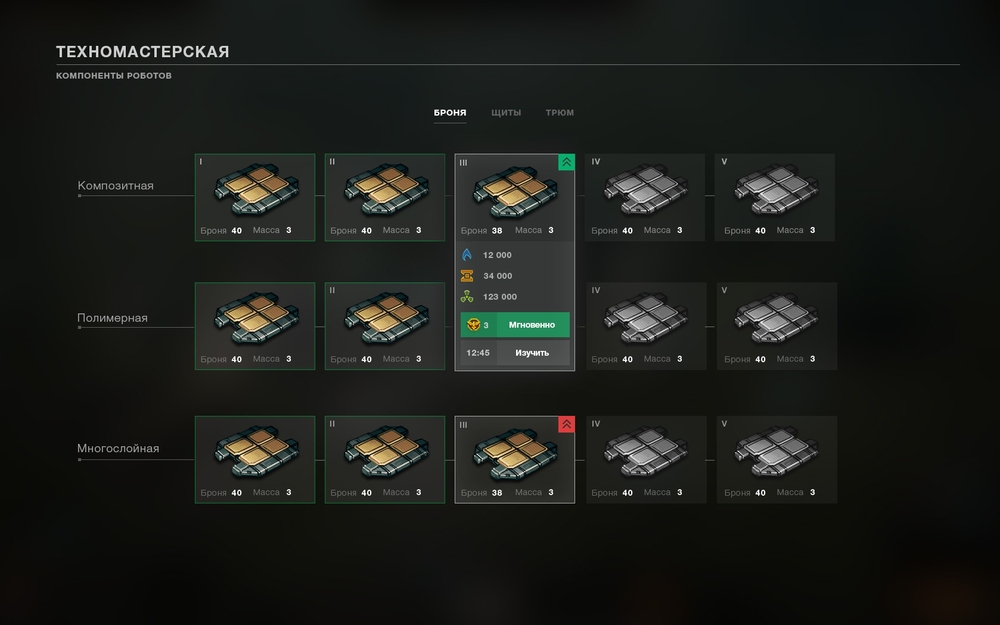
Concepts of possible changes: the robot research tree and the technology tree
Call to action
As you can see from my story, developing an existing and earning product is often harder and more interesting than creating something from scratch. It is necessary to correctly interpret the indicators, choose the most attractive directions of development, and when introducing features, you need to ensure that the existing functionality is not broken. Nevertheless, I believe that the strength of our team (which we plan to strengthen with a few more experts in the near future) will be enough to cope with this difficult task.In the next issue, I hope to tell you what the changes described above have led to. If suddenly I explained something too confused - you can ask a question in the comments. The last time, having failed to get an invite, I published the answers on behalf of Odnoklassniki with a long delay, when they were already of no interest to anyone. But I realized my mistake and now I will be more efficient, here I am: ivangrigorev . And if you want to make a game with us, write to me by mail .
